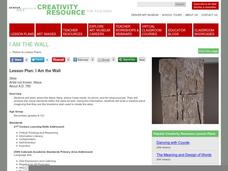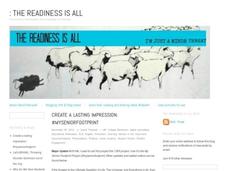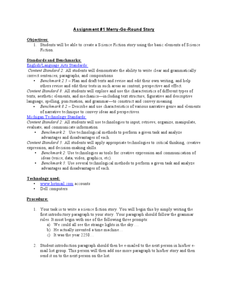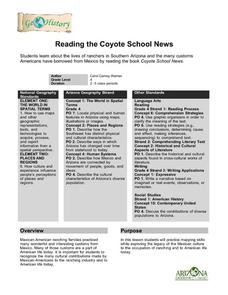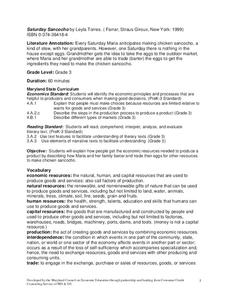Curated OER
Lesson: I Am the Wall
The Maya created amazing stone carvings and sculptures, but what were they for? Kids analyze the significance and purpose of a Maya stela and then write a creative piece. They imagine they are the stela, and write a story about what life...
Curated OER
Parts of a Story
Young scholars read a short fiction book and demostrate comprehension by identifying the main characters, setting, conflict, theme, and summarizing the main points. They organize the information in Inspiration and create a powerpoint to...
Curated OER
Faulkner's The Sound and the Fury: April Eighth, 1928: Narrating from an 'Ordered Place'?
Students describe Faulkner's use of time to structure the plot of The Sound and the Fury. They discuss the differences between first and third person narration and its effects on the novel. Discussion of the overall meaning is brought to...
Curated OER
Language Arts: Predicting and Clarifying Techniques
First graders discover predicting and clarifying skills while reading "The Old Woman and Her Pig." During the reading, they check their predictions while evaluating the characters, setting, problems, and solution. On the second day,...
Curated OER
Sherlock Holmes Characterization
In this reading comprehension worksheet, students respond to 8 short answer questions based on characterization techniques used in the Sherlock Holmes series.
Curated OER
Families: Different and the Same
Learners compare varying family structures. In this family structures lesson, students write a book about their family. Learners read The House on Mango Street.
Curated OER
Create a Lasting Impression: #Myseniorfootprint
Looking for some ideas for an end-of-year project for seniors? Here's one that asks seniors to highlight what they learned during their four years of high school.
Curated OER
Lesson: Beyond First Impressions
Just like the colors and techniques used to create a vivid image, learners will use exceptional language to create vivid stories. They examine the techniques used to tell a visual story in the painting, Road to Santa Fe. They then use...
Curated OER
Assignment # 1: Merry-Go-Round Story
Class members use e-mail and the merry-go-round story format to create a science fiction story. Each writer begins by selecting one of three prompts, crafting the introductory paragraph and sending the paragraph to the next person on the...
Curated OER
Creating Transitions
Fourth graders analyze the use of transitions in text. For this transitions lesson, 4th graders determine how and why a transition is used at a specific time in a piece of writing. They show transitions by using movements before...
Curated OER
Author's Day
Have your learners choose an author to study. One resource link gives a list of approved authors. Scholars read at least three works produced by that author and produce three separate book reports as well as a two-page author report....
Curated OER
Reading the Coyote School News: Lives of Ranchers in Southern Arizona
Fourth graders examine the effects of Mexican-American ranching on life today.
Curated OER
Fairy Tales
Students listen as the teacher reads fairy tales to students and identify patterns. They listen as the teacher re-reads the fairy tales and signal or recite patterns as they listen. Students identify patterns in the fairy tales. They...
Curated OER
Joyful Noise: Poems for Two Voices by Paul Fleischman
Do your young readers know that poems can be performed as a team? They listen to a few examples from Paul Fleischman's book Joyful Noise: Poems for Two Voices, paying attention to how the how readers work together. They examine the...
Curated OER
Saturday Sancocho
Second graders identify the economic principles and processes that are helpful to producers and consumers when making good decisions. Students will read, comprehend, interpret, analyze, and evaluate literary text as well as explain how...
Curated OER
Debate the Daily Dilemma
Have your class practice their persuasion skills by participating in a class debate. They will discuss a dilemma and detail each point of view. Divided into both sides of the argument, they work in groups to create a well-rounded...
Curated OER
Acting as a Pre-write Tool
Second graders use acting to help them in a prewriting activity to develop a story. In this prewriting lesson plan, 2nd graders form a character map and brainstorm ideas for their story.
Curated OER
Critical Analysis #1: "Videotape" Don DeLillo
In this critical analysis worksheet, students read "Videotape" by Don DeLillo and discuss the relevance of the author and date of publication, the general topic, and determine the type of writing. Students also summarize the work.
Curated OER
How to Write a Mystery
Was it the teacher with the ruler in the supply closet? Find out when you read mystery stories inspired by this presentation. Show the slide show to your pupils to give them ideas that will help them get started with writing their own...
Curated OER
Blending Fiction and Nonfiction to Improve Comprehension and Writing Skills
Students explore a content area by reading both fiction and nonfiction texts on the topic. They do more research online about the topic. After comparing the texts, they create their own written original work, using both narrative and...
Curated OER
Tell Me a Whopper!
Sixth graders investigate tall tales as a literary genre. They listen to a number of tall tales to discover how exaggeration is used as a story element. They write and publish a tall tale using word processing software. They illustrate...
Curated OER
Voices of Our People: A Patchwork of Cultures
Students view a gallery of photographs online and list objective and subject observations of the photos. They develop questions about the photos and write first person narratives about them.
Curated OER
Folklore in Zora Neale Hurston's Their Eyes Were Watching God
Learners read Zora Hurston's Their Eyes Were Watching God and explore her life history as well as novel analysis activities. In this novel analysis instructional activity, students identify elements in the novel and its overall literary...
Curated OER
Bark, Meow, Purr, Snort - Oh, What a Voice!
Students brainstorm differences between dogs and cats. They discuss the elements that make a story effective and write a story with a beginning, middle and end in the voice of a cat or dog.


